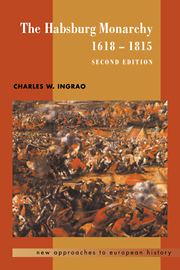Book contents
- Frontmatter
- Contents
- List of maps
- Genealogical tables
- Preface
- 1 The distinctiveness of Austrian history
- 2 The Thirty Years' War (1618–1648)
- 3 Facing east: Hungary and the Turks (1648–1699)
- 4 Facing west: the second Habsburg empire (1700–1740)
- 5 The Prussian challenge: war and government reform (1740–1763)
- 6 Discovering the people: the triumph of cameralism and enlightened absolutism (1765–1792)
- 7 The age of revolution (1789–1815)
- 8 Decline or disaggregation?
- Bibliography
- Index
- More titles in the NEW APPROACHES TO EUROPEAN HISTORY series
6 - Discovering the people: the triumph of cameralism and enlightened absolutism (1765–1792)
- Frontmatter
- Contents
- List of maps
- Genealogical tables
- Preface
- 1 The distinctiveness of Austrian history
- 2 The Thirty Years' War (1618–1648)
- 3 Facing east: Hungary and the Turks (1648–1699)
- 4 Facing west: the second Habsburg empire (1700–1740)
- 5 The Prussian challenge: war and government reform (1740–1763)
- 6 Discovering the people: the triumph of cameralism and enlightened absolutism (1765–1792)
- 7 The age of revolution (1789–1815)
- 8 Decline or disaggregation?
- Bibliography
- Index
- More titles in the NEW APPROACHES TO EUROPEAN HISTORY series
Summary
Had the monarchy won the Seven Years' War and regained much or all of Silesia, contemporaries and historians alike could have pointed to a number of factors in its success: Kaunitz's Diplomatic Revolution had forged a seemingly invincible coalition against Prussia; Haugwitz's dramatic restructuring of taxation and administration had supported a huge increase in the size of the army; finally, notwithstanding Daun's shortcomings as a field commander, his military reforms had improved the quality and equipment of those troops. Instead, failure prompted another round of introspection as the empress and her ministers now carefully scrutinized the system that they had created. The reconquest of Silesia was no longer their immediate objective; repeated setbacks on the battlefield had finally persuaded Maria Theresa to accept its loss. Rather it was the monarchy's security against the almost certain threat of renewed Prussian aggression.
A cause for immediate concern was the state debt, which had more than doubled over the past fifteen years from 124 to 280 million fl. In the first half of the century, Anglo-Dutch financial aid had helped the Hofkammer to avert bankruptcy. Although French subsidies were neither as plentiful nor paid as punctually, they were still considerable and had come with fewer strings attached. Indeed, whereas the British had abruptly cut off all aid to Prussia at a critical point in the conflict, Versailles continued to make good on its arrears for at least eight years after the conclusion of peace.
- Type
- Chapter
- Information
- The Habsburg Monarchy, 1618–1815 , pp. 178 - 219Publisher: Cambridge University PressPrint publication year: 2000

